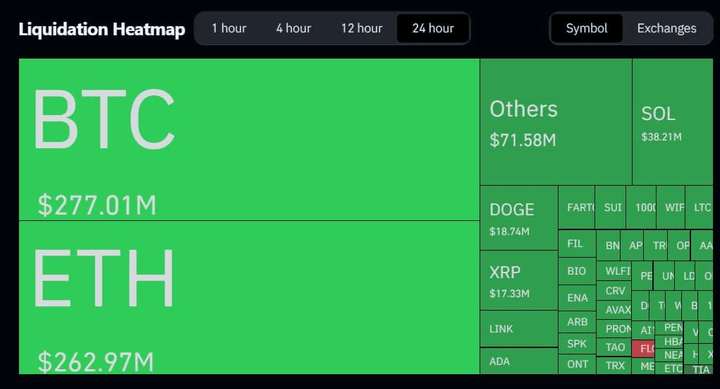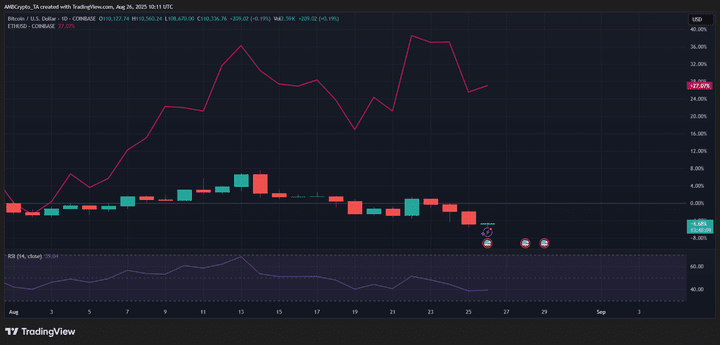During a period of extreme volatility, total cryptocurrency liquidations approached $800 million, with Bitcoin ($277 million) and Ethereum ($263 million) at the forefront. Over-leveraged long positions on major exchanges exacerbated the sell-off, concentrating stop-loss orders, and a $39.24 million BTC/USDT single order on HTX triggered a chain reaction of liquidations.
Bitcoin and Ethereum had the largest liquidation amounts: BTC $277 million, ETH $263 million.
Altcoins also suffered significant losses: SOL $38 million, DOGE $18.7 million, XRP $17.3 million.
Most liquidations came from leveraged longs; the largest single order was a $39.24 million BTC-USDT position on HTX.
The amount of cryptocurrency liquidations surged to nearly $800 million, with Bitcoin and Ethereum leading the way — understand the reasons and risk mitigation measures. Read now for data-driven analysis.
What triggered the recent wave of cryptocurrency liquidations?
After Bitcoin failed to hold a key psychological level, cryptocurrency liquidations escalated, triggering a chain reaction of long liquidations in the derivatives market. Concentrated stop-loss triggers and massive leveraged positions (including a $39.24 million BTC-USDT order on HTX) intensified downstream selling pressure within minutes.
Bitcoin and Ethereum suffered most of the losses, with BTC losing $277 million and ETH losing $263 million.

How did altcoins perform during the sell-off?
Altcoins are significantly affected by overflow selling. Solana (SOL) had approximately $38 million liquidated, Dogecoin (DOGE) about $18.7 million, and Ripple (XRP) around $17.3 million. These figures indicate that not only BTC's volatility but also the overall market deleveraging has caused losses in the derivatives market.
Data shows that most liquidations came from over-leveraged longs, with the largest single order ($39.24 million BTC-USDT position) recorded on HTX.
Did BTC trigger the sell-off?
Bitcoin fell below a key psychological level, triggering a wave of liquidations. The chart shows that BTC struggled to maintain this level, with bearish momentum dominating the previous week. As of this writing, the RSI hovers around 39, indicating that the market is nearing oversold conditions, but remains fragile.

How should traders manage liquidation risk?
Reduce leverage, stagger position sizes, and use limit orders to control entry. Maintain stop-loss levels to reflect market volatility rather than impulsive reactions. Monitor funding rates and exchange concentration to avoid excessive risk exposure to a single counterparty.
Practical steps to reduce liquidation probability
Reduce leverage and cut position sizes during periods of high volatility.
Use diversified entry points and set strict stop-losses.
Track funding rates and on-chain metrics for early detection of pressure.
Frequently Asked Questions
What was the total amount liquidated in this event?
According to CoinGlass market monitoring, total liquidations approached $800 million, with BTC at $277 million and ETH at $263 million.
Which exchange experienced the largest single liquidation?
The largest single liquidation on record was a $39.24 million BTC-USDT position on the HTX platform. This massive order triggered various exchanges to issue stop-loss and margin call notifications.
Are these liquidation events healthy for the market?
Large-scale liquidation events can eliminate excess leverage and reduce bubbles, often leading to clearer price discovery afterward. However, this also increases short-term volatility and counterparty risk for leveraged traders.
Key Points
Main Drivers: Over-leveraged longs and concentrated BTC sell-offs exacerbated the liquidations.
Distribution: BTC $277 million and ETH $263 million accounted for nearly $800 million in total liquidations; SOL, DOGE, and XRP were also impacted.
Trader Actions: Reduce leverage, diversify positions, and implement strict risk management to limit risk exposure.
Conclusion
The nearly $800 million in cryptocurrency liquidations highlights the market's sensitivity to leverage and psychological levels. Bitcoin and Ethereum bore the brunt, while altcoins were affected by spillover effects. As the market stabilizes, traders should prioritize risk control and monitor funding and concentration metrics. COINOTAG will continue to track the latest developments and provide data-driven analysis.


